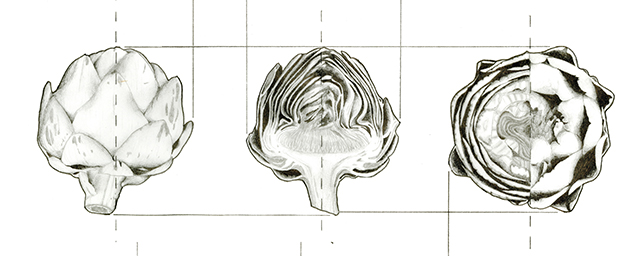

A "warm up" that introduces students to the general methodological pattern adopted by the projects that follow. Through this exercise, students demonstrate a basic proficiency in orthographic projection, analytical methods, and design through iteration.
To begin, from the produce available at Berkeley Bowl students select a variety of fruit or vegetable. To qualify, the selected fruit or veggie must be about the right size (2" diameter minimum, 8" diameter maximum), relatively cheap, and able to be cut easily and cleanly. Additionally, it should be hollow to some degree - that is to say that it contains both flesh and empty space when sliced open. Select and purchase at least three of the chosen variety of fruit to bring back to the studio for analysis.
Measure and draw the fruit using the standard orthographic three-view layout of front, side, and top. Select the angle of these views carefully as to reveal as much spatial information about the fruit as possible: one of the views should be elevational, one sectional, and one a combination of these two.
Draw the fruit as accurately and realistically as possible, while taking account of the media employed. Most lines, especially section lines and major contour lines, ought to be drawn mechanically using a rigorous process of measure. Employ any means in order to achieve this (including calipers, rulers, photo-reproduction or digital scanning and tracing) so long as the final marks on the page are made by a pencil in your hand. Secondary lines on the drawing, such as those depicting texture or shading, may be made freehand. If the fruit is very large, it may be necessary to scale down your drawing. Repeat this process three times.
As we will explore in our second "departure" in studio on notation, abstraction may be understood as the reduction of information such that the only qualities that remain are those most relevant for a particular purpose. Using an invented notational system, produce an abstract drawing of the chosen fruit as a single overlay that describes all three analysis drawings from stage one.
In that all three pieces of fruit depicted in stage one are of the same variety, and the abstraction drawing must apply to each of them, this drawing naturally suggests questions of typology. Which qualities are unimportant to the purposes of identifying a member of the type, and which vary within the variety? Is color essential to "appleness", or is fur inherent to our understanding of a pear? If so, depict these qualities in a clear and straightforward way. If not, they may be edited out. Identify only the most salient qualities of your subject - those which serve to differentiate it from other families.
Craft your overlay drawing such that another author may follow and, using only this overlay, be able to produce a valid drawing of your variety of fruit. Keep in mind a combination of lines, descriptive text, notes, and dimensions may be used. Also keep in mind that it is equally valid to define ranges of variation as well as fixed dimensions.
Obtain an overlay drawing produced by one of your peers, ensuring that both the author and the fruit depicted remain anonymous. Combine your and this new overlay drawings in equal proportions in order to produce a new hybridized abstract overlay drawing. Use media and format specifications from stage two.
Using the hybridized abstract overlay drawing from stage three as a guide, produce a three-view description of a new "strange" fruit not found in nature. Use media and format specifications from stage one.
There's more!
Some other projects from this same class have been posted, as well as some interesting student work from this same year.